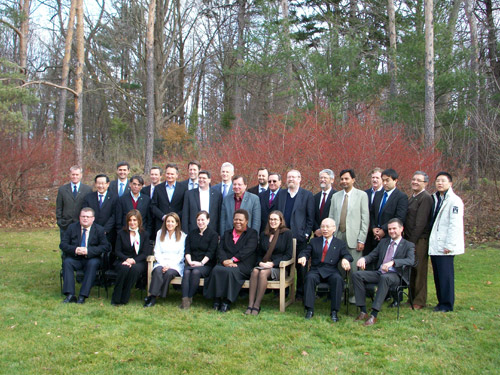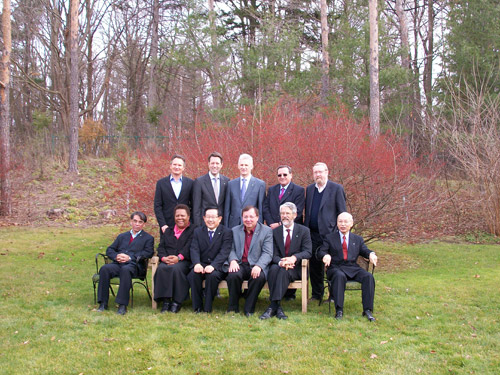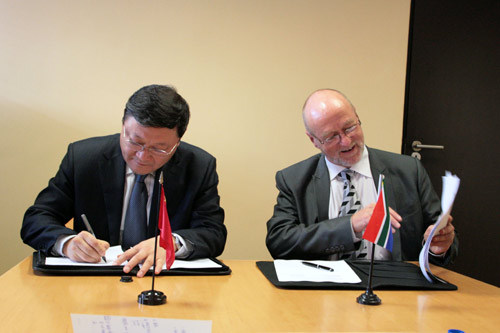CHINA SCIENCE AND TECHNOLOGY
NEWSLETTER
The Ministry of Science and Technology
People's Republic of China
|
|
|
N0.602 |
November 30, 2010 |
|
|
|
|
|
|
|
|
IN THIS ISSUE
|
|
*WAN Attended Carnegie Ministerial Meeting
*China-South Africa S&T Commission Meeting
*Genetic Variation Found among Elite Inbred Corn Lines
* Corn Protein Targeting HIV-Infected Cells
* High Conductivity Nano-Powder
*China Sits 12th for SCI Citation
*China Won Iris Recognition Contest Again
|
|
INTERNATIONAL COOPERATION |
WAN Attended Carnegie Ministerial Meeting


At the invitation of Howard Alper, Chair of Canada Science, Technology and Innovation Council, and David Sandalow, Assistant Secretary of the U.S. Department of Energy, WAN Gang, Chinese Minister of Science and Technology, visited Canada and the United States from November 19 to 24, 2010, and attended the 38th meeting held by Carnegie Group during the period of November 20-21, 2010 for science ministers in the suburb of Toronto. WAN also visited Canadian and US research institutions.
Science ministers and senior advisors from Canada, the European Union, France, Germany, India, Italy, Japan, Mexico, Russia, South Africa, the United Kingdom, and the United States attended the meeting. Participants discussed four major issues, including meeting global challenges with enhanced innovations (knowledge transfer and associated commercialization), digital economy, clean energy (carbon capture and storage), and global research infrastructures (governance and funding). Participants also listened to the briefing on counterfeit drugs in the developing countries. Under the title of "Addressing global challenges with enhanced innovations", WAN spoke to the audiences of China's innovation policy, basic research and cutting-edge technology development in line with major strategic national interests, preferential policies to encourage innovation and protect intellectual properties, and China’s active participation in international cooperation. WAN also spoke about the measures China has adopted to develop information and communication technologies, to stimulate industrialization using information technology, to support the development of modern service industry, and to narrow down the digital divide between the urban and rural areas. WAN said China will host a ministerial meeting for the fourth round of Carbon Sequestration Leadership Forum in 2011, and added that people should pay more attention to resource oriented utilization of carbon dioxide in an innovative manner, along with joint new technology R&D and associated demonstration. WAN also talked about the experience China has acquired in building and running open mega research infrastructures, and China’s participation in international mega research programs.
During the meeting, WAN had talks with Gary Goodyear, Canadian Minister of State for Science and Technology. WAN visited on November 22 a Fuel Cell Innovation Center under the National Research Council Canada in Vancouver, and Ballard, and had a talk with Szumski, Vice President of National Research Council. On November 23, WAN visited the U.S. Department of Energy Lawrence Berkeley National Laboratory in San Francisco.
China-South Africa S&T Commission Meeting

November 15, 2010, a China-South Africa Inter-governmental Joint Science and Technology Commission meeting, and the fourth round of China-South Bilateral Science and Technology Sub-Committee meeting were held in Pretoria, the capital of South Africa. The meeting was co-chaired by WANG Wei, Chinese Vice-Minister of Science and Technology and Derek Hanekom, South Africa Deputy Minister of Science and Technology.
Both sides agreed to enhance future collaborations in the areas of biotechnology , mining/smelting, astronomy, indigenous knowledge systems (including traditional medicine), palaeontology, renewable energy, new materials, nanotechnology, agriculture, information and communication technology, transportation, environment, and climate change, in the spirit of the Joint Declaration on the establishment of an all-round strategic partnership between the two countries, and under the framework of a range of bilateral committees and programs. Both sides agreed to start in early 2011 the sixth round of joint research projects solicitation focusing on five major areas, including biotechnology, mining/smelting, environment and sustainable development, indigenous knowledge systems (including traditional medicine), and renewable energy. Both sides also agreed to expand the scale of joint research programs, with a raised number of projects from 10 to 15. Additionally, both parties signed a protocol for the joint commission meeting.
Genetic Variation Found among Elite Inbred Corn Lines
Scientists from China Agricultural University Corn Center, Beijing Genomics Institute, University of Iowa, and University of Minnesota reported their findings in the recent issue of the journal Nature-Genetics on the implications of gene loss and gain on the strength of inbred corn lines
Researchers resequenced a group of six elite inbred corn lines, and uncovered more than 1,000,000 SNPs, 30,000 indel polymorphisms, and 101 low-sequence-diversity chromosomal intervals in the corn genome. They also identified numerous complete genes that show presence/absence variation among the resequenced lines, and studied the potential roles of complementation of presence/absence variations and other deleterious mutations in contributing to heterosis. Researchers spotted the genetic variation in inbred corn lines caused by the presence/absence of genes. With the help of SAOPdenovo, researchers assembled the sequence missing in B73 inbred lines, and found the genes missing in the publicized B73 reference genome. The finding provides valuable variation markers for breeding high-yield elite inbred corn lines, while enriching the database of corn genome, making more data available for mining corn genome and associated genetic resources.
Corn Protein Targeting HIV-Infected Cells
Thanks to their multiple-year efforts, SHAW Pang-Chui and coworkers at the Chinese University of Hong Kong, in collaboration with a team led by ZHENG Yongtang of CAS Kunming Institute of Zoology, found a switch-on mechanism to activate corn ribosome-inactivating protein for targeting HIV-infected cells. The finding was published in the recent issue of Nucleic Acids Research.
Financed by Hong Kong Research Grants Council, national 973 program, national major earmark S&T projects, and the Chinese Academy of Sciences, the research teams led by SHAW Pang-Chui and ZHENG Yongtang made a range of structural decoration and transformation to the internal inactivation region of corn ribosome-inactivating protein (RIP), and found a switch-on mechanism to activate corn ribosome-inactivating protein for targeting HIV-infected cells. Experiments were made at the cellular level to add HIV-1 protease recognition sequences to the internal inactivation region, and activate maize RIP variants by HIV-1 protease in vitro and in HIV-infected cells. Among the variants generated, two were cleaved efficiently by HIV-1 protease. The HIV-1 protease-activated variants showed enhanced N-glycosidase activity in vivo as compared to their un-activated counterparts. They also possessed potent inhibitory effect on p24 antigen production in human T cells infected by two HIV-1 strains.
High Conductivity Nano-Powder
Not long ago, CAS Changchun Institute of Applied Chemistry developed an environment-friendly nano-powder material with high electric conductivity. According to a briefing, the patented new material, named "high conductivity aluminum doped zinc oxide nanoparticle", enjoys numerous merits, including high crystallinity, uniform doping, controllable morphology, and fine scattering and dispersion performance, with a volume resistance as low as 15Ω·cm. The nanoparticle material can be applied in a broad range of areas, including scientific research and industrial applications, being conductive fillers for transparent conductive electrodes and antistatic composite materials.
YANG Xiaoniu, a researcher at the Institute, said it is a simple process to prepare the novel nano powder material, featured with a short cycle and low cost, and surfactants/templates free, desirable for large-scale production. In addition, the invention has created a new approach for preparing monodisperse part of other transparent conducting oxides.
Mountain Biological Protection Has Its Law
Researchers at CAS Kunming Institute of Zoology said on Nov. 26, 2010 that they have sorted out the biological law for protecting the creatures in the mountains, through a bird diversity study. Based on the study of the spatial and temporal distribution of birds across the Ailao Mountain area, researchers found that the birds composition in the area presents a high spatial heterogeneity, though the area is not very large. For example, birds would see a fast changed composition over the coastal gradient, followed by slopes. The birds composition at lower elevations shows a higher spatial heterogeneity, compared with the higher ones. The finding facilitates biodiversity conservation efforts in the mountainous areas in Asia, and associated protection design.
Dr. WU Fei, the project leader, said the study results show that when protecting a mountainous area, the protection shall not be merely confined to the mature forests at the top of the mountains. One has to take into account the vegetations grown on different elevations and slopes. For example, more areas need to be protected at low elevations, compared with the higher one.
1-D Deposited Atom Nano Grating
A team, made up of the scientists from China Institute of Metrology, Tongji University, and National University of Defense Technology, has recently rolled out a prototype one-dimensional deposited chromium atom nano-grating piece (213.1nm±0.5), thanks to their 3-year efforts of mastering the chromium atom deposition theory and associated nano-grating technology. Researchers also developed a device to test atom deposition in a highly vacuumed environment. The standard one-dimensional nano-grating piece has passed the metrological verification of professional testing agencies. The development makes China one of the few countries in the world able to work on deposited atom grating technology, making the localization of standard nano measuring materials possible, and providing a fundamental solution to addressing the traceability of Chinese made nano measuring instruments and associated calibration.
China Sits 12th for SCI Citation
According to the statistics released on November 26, 2010 by the Institute of Scientific and Technical Information of China in Beijing, in 2009, SCI (Science Citation Index) has collected 108,800 papers with Chinese researchers as first author, of which 16,800 (15.5%) papers enjoyed a citation frequency that is higher than disciplinary averages, or 4 percentage points up compared with 11.5% registered in 2008.
Statistics show that SCI database has collected 127,500 Chinese papers in 2009, accounting for 8.8% of the papers collected by SCI in the year, ranked 2nd, though flat with 2008. When the papers by Hong Kong and Macau authors are removed, mainland China published 119,500 papers, or 25.3% up, compared with 2008. Even under the calculation, China remains No. 2 in the world, or two more advanced, compared with the preceding year. Meanwhile, this is the first time for mainland China to rank second place in the world.
As far as times of citation are concerned, Chinese S&T personnel published 720,000 international papers during the period of 2000-2010. The papers have been cited for 4.23 million times, ranked 8th in the world, or one seat advanced over the previous year statistics. The papers were cited 5.87 times on an average, slightly higher compared with 5.2 times in the previous year, though quite a gap from the world average of 10.57 times.
China could lag further behind, in terms of citations per paper. For example, China sat in 12th place among 14 countries that have published 200,000 papers during the period of 2000-2010 on a combined basis. China’s citations per paper are lower than Japan and Korea, though slightly higher than India.
The Institute also released the EI’s collection of Chinese papers. In 2009, EI database collected 97,900 Chinese papers, or 23.9% of the paper collected by the EI system in the year, which made China sit in No. 1 place, or 7 percentage points more, compared with the United States, the No. 2 position holder, enjoying an increase of 9.5%. When Hong Kong and Macao are removed, mainland China came up with a number of 93,100, or 9.4% up over 2008, accounting for 22.7% of the papers collected by the EI system in the year, or 1.2 percentage points more against the preceding year, making China No. 1 in the world.
China Won Iris Recognition Contest Again
it is reported November 24, 2010 from the Chinese Academy of Sciences Institute of Automation that a Chinese team, headed by TAN Tie-Niu, a National Key Laboratory researcher, has once again won the toughest and largest international competition on professional iris recognition evaluation among 41 teams from 25 countries or regions, with an absolute advantage of 41.3% over the second place winner.
Chinese researchers have been developing innovative iris recognition technologies for more than a decade, including iris recognition information collection, from a single eye to two eyes, from static to dynamic, and from the close range to the long range recognition, and a range of other key technologies, including imaging device, image processing, feature extraction, recognition, retrieval, and security. They also established a theoretical and methodological system for iris comparison and recognition, along with the largest sharing database in the world. The database has been used by more than 3,000 research teams in some 70 countries or regions, facilitating the development of iris recognition technology.
Comments or inquiries on editorial matters or Newsletter content should be directed to:
Department of International Cooperation, MOST 15B, Fuxing Road, Beijing 100862, PR China Tel: (8610)58881360 Fax: (8610) 58881364
http://www.most.gov.cn

